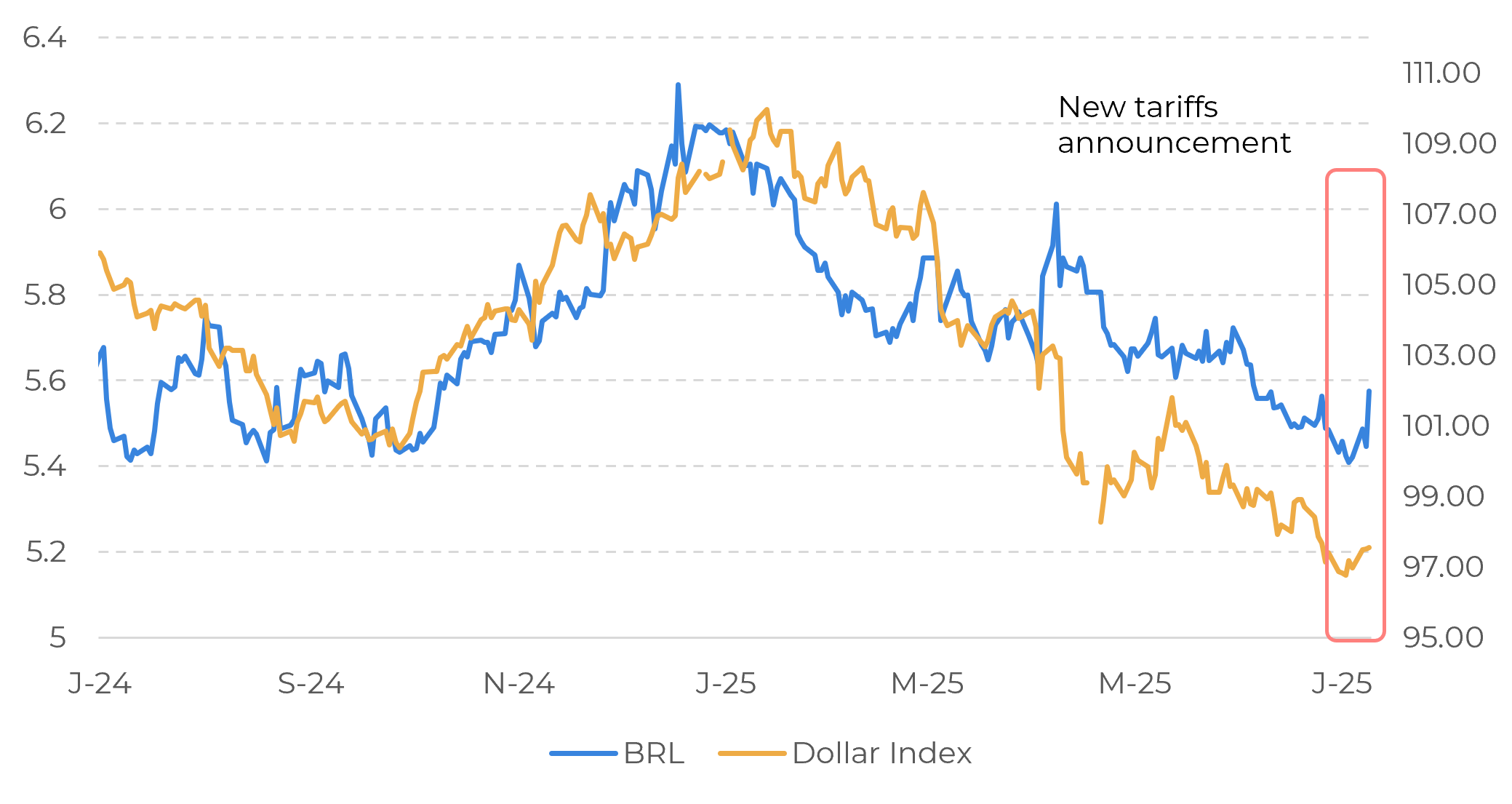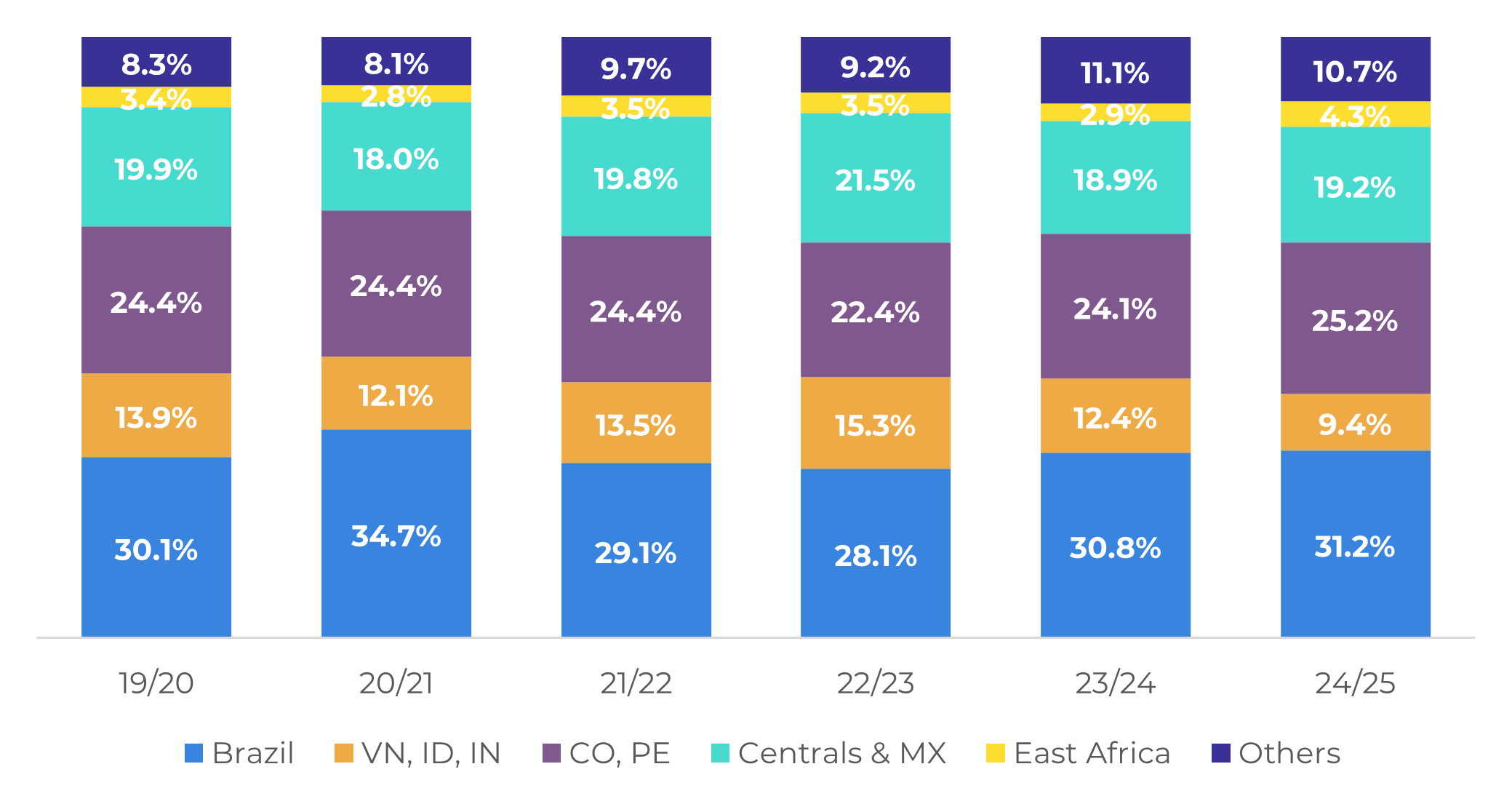
Could Trump’s 50% levies on Brazilian goods affect the coffee market?
- On Wednesday (09), US President Donald Trump imposed a shocking 50% tariff on exports from Brazil, the largest economy in Latin America and a top coffee producer, rather than the previously indicated 10% levies in April, bringing volatility to the BRL. Following the announcement, President Luiz Inácio Lula da Silva stated that Brazil would consider reciprocal measures should the negotiations fail to progress.
- Brazil is the 15th US trading partner, currently with a trade deficit with the country. Among Brazilian top exports to the US are crude oil, semi-finished steel, pig iron and coffee, among other products.
- While Brazil now holds the highest tariffs among trading partners, the US has also imposed levies on other countries. As a net importer of goods, our main concern lies in its possible impacts on the country’s inflation.
- The US is also the world's largest coffee consumer, with Brazilian coffee accounting for about 30% of all US imports of the product. Thus, if the current tariffs are implemented, they could impact coffee prices in the country and affect imports.
- It's important to note that Brazil is not only the largest coffee producer, but it also has the most coffee available at this time of year, at least when it comes to Arabica coffee, since most other origins are in their off-season.
Could Trump’s 50% levies on Brazilian goods affect the coffee market?
New Tariffs to take place on August 1st

Source: LSEG Hedgepoint
After the announcements were made, the dollar rose against other currencies, especially those of affected countries, such as the yen and the Brazilian real. The BRL has appreciated in the past months, especially after the rise in Brazilian rates in June. However, the strength of the US currency also stems from robust economic indicators from previous days such as the resilience of its labor market.
However, the immediate concern for the market is a possible rise in inflation as a result of imposing tariffs on trade partners, such as Brazil, especially as the US is a net importer of goods, which could also leave less room for future interest rate cuts. In this sense, despite the recovery in the value of the dollar during the week, the index remains close to its lowest level in three and a half years, having declined around 10% this year.
This could be mainly explained by investors viewing the US economy as risky, given all the trade and economic uncertainties, with the dollar losing part of its place as a "safe haven” currency. Besides the current volatility in trade policies, the market watches closely the proposed Trump's tax cut and spending bill (which has contributed to the U.S. dollar Index weakness) and Fed’s next moves.
Brazilian Currency X Dollar Index

Source: LSEG
US: Coffee Imports by Origin (% of total)

Source: U.S. International Trade Commission
Regarding the coffee market, a 50% levy on Brazilian goods could have a direct impact on the sector, since not only Brazil is the largest producer in the world, but the US is its largest importer. In the past few seasons, the Brazilian beans account for about 30% of all US coffee imports. If the beans are taxed at 50%, it would impact coffee prices for Americans and possibly result in fewer shipments to the US and changes in global coffee trade flow.
It's worth mentioning that despite rising coffee prices, U.S. coffee import data has shown a recovery to close to average levels so far in the 24/25 season, after dropping in the 23/24 and 22/23 seasons. While coffee prices are higher than in previous years, the impact on consumers’ income is lower than in economies such as Brazil, where the product still takes a bigger part of income.
However, further price increases could impact imports and demand, especially since Brazil is the US's largest coffee trading partner and can currently meet US demand. Brazil also has a higher coffee availability at the moment since most other countries, especially those that produce Arabica, are in the off-season. Additionally, other major players, such as Vietnam, have high tax rates (currently, 20% levies), which could further impact coffee prices and demand in the US. Although changes to Trump's tariff policy are possible, we are likely to see more market volatility in the coming months.
US: Coffee Imports (M bags)

Source: U.S. International Trade Commission
US Coffee Retail Price (USD/lb) and the Reason Between US Minimum Wage x Coffee Price (%)

Source: US Bureau of Labor Statistics, Hedgepoint
In Summary
As for the coffee market, the 50% tariff on Brazilian imports could pose significant risks, as Brazil is the major global producer and the top supplier to the United States, accounting for approximately 30% of its coffee imports. Although recent data suggest a recovery in shipment volumes, heightened tariffs may raise prices, potentially change trade flows, and dampen U.S. demand. Additional factors, such as Vietnam’s existing 20% levy and reduced availability from other Arabica-producing nations, may contribute to further volatility in coffee prices and global trade patterns.
Weekly Report — Coffee
laleska.moda@hedgepointglobal.com
livea.coda@hedgepointglobal.com
Disclaimer
Contact us
Check our general terms and important notices.
We have updated our Terms & Conditions to reflect improvements to our platform, data handling practices, and the overall experience we provide to our clients.

